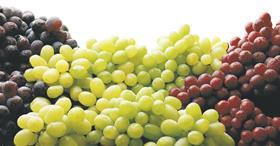
Australia's table grape industry is celebrating a milestone this week after the initialling of a protocol in Beijing to give their fruit direct access to the Chinese mainland.
Biosecurity Australia has confirmed that the protocol was initialled on Monday afternoon by the agricultural-technical counsellor in Beijing and an official from China's quarantine body AQSIQ.
While a formal signing ceremony will take place at a date to be confirmed, the initialling of the protocol is enough to bring it into effect, according to Jeff Scott, CEO of the Australian Table Grape Association.
Before shipments can commence, however, Chinese quarantine inspectors must visit vineyards and packhouses in Australia to ensure compliance with the protocol. With the start of the season on the horizon, Mr Scott is hopeful that this will happen in the coming weeks.
'We've proposed that the Chinese inspectors come over in November, when they should see the flowering and bunch-trimming but most of all they can see our systems-based regime that we have in place,' he told Fruitnet.com. 'Once they give the okay, we'll be exporting with this upcoming crop.'
Securing direct access to China, which comes on the back of several years of negotiations, marks a breakthrough for the industry, but the outcome is all the more remarkable for the fact that the resulting protocol looks to be commercially viable.
The protocol involves in-transit cold treatment for fruit fly, along with a 'systems-based approach' for managing other pests and diseases of concern. 'To our knowledge, this is the first time China has accepted in-field packing with a systems-based approach,' said Mr Scott. 'We have gone through and established a work plan with AQIS and that will be distributed to growers and packers this week.'
Interest from Australian grape growers in the China export programme has been strong, with more than 120 businesses registered, according to Mr Scott. 'I'd say virtually every grower in the Sunraysia region is signed up to take part, which shows the'll all take up the opportunity to export to China,' he said.
David Minnis of Australian export company M&A Exports also hailed the activation of the protocol for access to what represents the industry's largest export market. 'We're pleased it's happened – it's taken around eight years,' he told Fruitnet.com. 'When your dollar is about one-to-one with the US dollar, if this cuts your landed costs into China, it will be taken up quickly by growers.'
While direct access will reduce costs compared with shipping into the Chinese mainland via Hong Kong, Mr Minnis says the extent of those savings remains to be seen. 'You have to factor in AQIS inspection charges `here`, which are going to be more, the cost of shipping with in-transit cold treatment, the cost of clearance in China and then a 13 per cent VAT on top of that,' he detailed.
'Once that's all taken into account, I think we're looking at a saving of around A$3 per carton to our landed price `compared with the shipping via the traditional Hong Kong re-export channel`, which is not all that great if your landed cost in China before was A$46 per carton.'
Besides costs savings, Mr Minnis sees much broader benefits flowing from direct access, however. 'There's no doubt this is good news,' he said. 'It means we can promote `our fruit` in China now, and it give us access to the entire Chinese seaboard.'
Mr Scott says the protocol will open up a new market to Australian table grapes in China. 'At the recent ASIA FRUIT LOGISTICA event in Hong Kong, we received a lot of interest from Chinese importers who said now that we have legal access, they would import our fruit where they couldn't previously,' he told Fruitnet.com. 'These were some of the major distributors with large networks covering supermarket chains, high-end hotels and the like.'
Australian grapes have already gained a strong following in Guangzhou's Jiangnan wholesale market, but their profile beyond that point remains to be developed. 'The traditional Guangzhou market will still be there and it won't diminish at all, but this is a new opportunity,' Mr Scott said. 'We're telling growers it could take three to five years to develop trade but we have high expectations for the future.'
Australian table grape exports to Hong Kong have been valued at around A$50-70m in recent years, but Mr Scott believes the industry could potentially be doing a similar trade into both Beijing and Shanghai in years to come.
Mr Minnis points out that it will take time for the industry to educate Chinese buyers in central and northern coastal areas regarding the higher price requirements for Australian grapes as compared with product from Chile.
The first direct shipments to China won't leave until 2011 and they will miss the boat for Chinese New Year, he predicts, not least because the season is running around two weeks later than normal.
'We `the Sunraysia region` don't expect to be picking any grapes, even Flames, before Christmas,' he told Fruitnet.com. 'Chinese New Year falls on 3 February, so we'd have to be loading fruit by the end of the first week of January to make the cut-off, and since the protocol is only for seafreighted product, we won't be supplying product for Chinese New Year.'






No comments yet